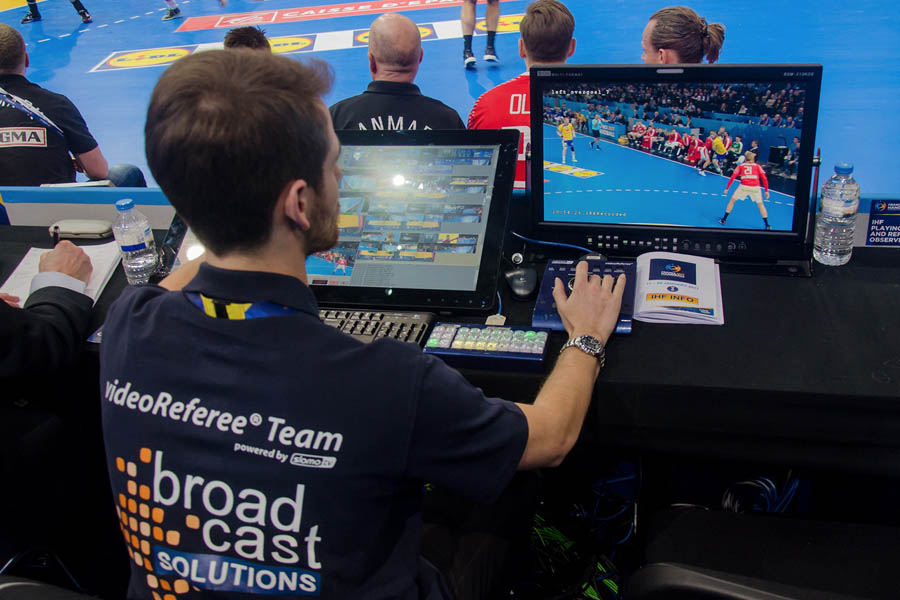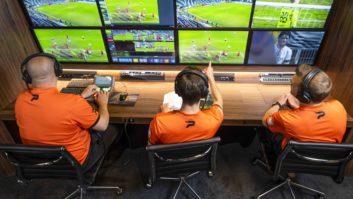
Slow motion replays have become an intrinsic part of live sports broadcasts today, but imagine if the system that captured that footage was of such high resolution and so fast in its replay capabilities that it could be used by officials in the game to help judge incidents? Ten years ago, this was the big dream of Igor Vitiorets, the CTO of Slomo.tv
Working closely with Vladimir Mironov, the chief engineer of Moscow Krylatskoye Ice Arenas, slomo.tv developed the concept of a modern video judging system for ice hockey. The first four-channel sports video judging system, videoReferee, was used at the 2007 World Hockey Championship in Moscow. In this article, Igor Vitiorets charts the course of a system that is found at the heart of many modern sporting events – from the Rio games to next year’s 2018 FIFA World Cup Finals in Russia.
This story starts with the lightening fast and frequently brutal game of Ice Hockey. In particular the Continental Hockey League (KHL) where referees needed to keep track of goal-line incidents, and other incidents such as icing, offside and fouls. We saw the answer being the use of panoramic cameras to record the action on the ice.
However, back in 2007, it turned out that when a panoramic camera records in standard definition the puck becomes invisible. At resolutions of 720 pixels across a 60m rink, the 8cm puck accounts for just one pixel of the image. So, it became necessary to add an HD SDI video input for Full HD panoramic camera.
At the same time, we needed to develop interfaces between our server systems and scoreboard match controllers. The game information (Time, Score, Penalty Time, etc.) received from the scoreboard computer via a special interface is always synchronised with recorded video of all channels. Having full synchronisation of video cameras with the scoreboard timing is very important because, in accordance with the rules, only goals before the time has been stopped are counted. Slomo.tv equipment is compatible with more than 20 types of Scoreboard Controllers, including Omega- Swiss Timing, Westerstrand, Nautronic and Bodet.
The technology used in video refereeing was evolving fast. And we are proud to have been at the very roots of it. But it is not just the technology or sales that are important: we are passionate about “fair play” in sports and want everyone to have this opportunity. However, the needs of broadcasters also should be considered. The advantage of our core technology is that it could be easily upgraded and modified to ever changing needs.
In 2011, we developed a system capable of recording up to 11 channels so that they can monitor in-play incidents across the entire field. Since then, forward-thinking hockey clubs that selected 11-channel videoReferee-IIM2 have been rewarded by recent changes in KHL regulations. These clubs did not have to change or upgrade their servers – they could remotely upgrade the server software and its settings and very easily install two additional cameras.
The Ice Hockey club AkBars is one of them: its Videoreferee 3G SDI system with 12 cameras working in 1920х1080 50p resolution purchased in 2014 already has a number of unique features: in contrast to standard interlaced Full HD 1920×1080 50i/60i video, 3G works with progressive scan, which doubles the recorded detail and also eliminates “washed” video. Disputed moments can be easily analysed with a much better picture. This system is able to record up to 10 channels in any combination and simultaneously search up to four channels; it also produces video-archive recording in H264 format.
However, the latest Slomo TV Videoreferee 4G system, which will be launched at IBC2017, supports 16 channels of 3G SDI video as well as works simultaneously with 3G/HD/720p signals at any combinations. This is very important if OB vehicles are used. Also, this new system has an additional output for multi-viewer for the referee’s assistant. It supports the vR-Keypad , which allows fast creation of event labels and immediate search by designated keys.
The precise time capabilities of the new system is such, that it is capable to 1/10 second accuracy. To comply with the latest requirement of KHL on archiving, SlomoTV has added a batch-export functionality in the H264 и XDCAM format. Now, the operators can send all material to archive with just one button push.
Football adopts video referees
In recent years, the concept of the video refereeing has gained appeal in many sports and today it is a hot topic at the world’s most popular sport – football. In July 2012, the International Football Association Board voted unanimously to amend the Laws of the Game to permit (but not require) goal-line technology. The technology was used at the 2014 FIFA World Cup. In April 2016, the Italian league, Serie A, was selected by the IFAB to test video replays for the 2016–17 season.
Then, in May 2016, Slomo.tv’s 12-channel videoReferee system was demonstrated by Broadcast Solutions GmbH at the FIFA workshop in Amsterdam, resulting in its acceptance by FIFA. In September 2016, the Video Assistant Referee (VAR) system, was first used in an international friendly between Italy and France for testing with plans for implementation at the 2018 FIFA World Cup.
Video refereeing in football, unlike cricket or tennis, does not allow appeals from participants. Instead, match footage is constantly reviewed by a VAR, who alerts the on-field officials if they feel a reviewable error has been made. Only the referee can initiate a review, either on the VAR’s recommendation, or if he feels a mistake has been made.
Slomo.tv is now offering the eighth generation of its sports video judging system videoReferee-V. It was announced at NAB 2017, and now it has been fully tested in the real game environment. The European premiere will take place at IBC2017. This system was created, taking in consideration the specific requirement of football. The new system sets a record: 24 channels of HD/3G. Now any competition can be “covered” by one server. The referees can analyse incidents frame by frame concurrently from several camera angles. The video image can also be zoomed in to scrutinise the action in the finest detail. Events can be marked live or on recorded video and they are instantly available for review.
What makes Slomo.tv’s solution different from those offered by other providers and manufacturers, is how it manages video compression. By using Intel’s Media Server Studio (a tool suite that provides the Intel Media SDK, runtimes, and advanced analysis tools for media, video and broadcast application development) to optimise, accelerate and compress its video streams, the company’s developers achieved a high level of flexibility and efficiency.
To display so many channels requires monitors with more than 1920×1080 resolution. Now, the replay screens can have resolution of up to 4K, which provide detailed images of all 24 channels. Since the system can work with 3G signals, when investigating disputed moments the images are twice as sharp as they are when working with HD signals. Another noticeable feature of this new system is its ability to work with 720p, HD and 3G signals on a single project.
Also, VideoReferee-V has an SDI output option for providing to broadcasters the output from the referee’s monitor. The video signal quality complies with professional broadcast requirements.
When an event is created, the system remembers the currently active channel, and when returning to this event, it starts with the same view. Marked events are also used to create video reports with highlights of the game’s most controversial moments. Using the vR-Keypad, the operator or assistant can assign with a single click different event tags. The system’s search engine enables the operator to instantly find tagged events.
The standard videoReferee®-V configuration includes two monitors – an engineering interface monitor with built-in multiviewer of all channels and a folder of marked events, and the referee’s monitor with a controller for the video judge. The video judge can work with 1, 2, 3 or 4 cameras simultaneously in live or search mode, helping accurate and quick decision making. Users are able to create different presets of channels. The system can also magnify any frame for detailed analysis.
Besides the referee’s and engineering monitors, videoReferee®-V can accommodate a third monitor working as a separate multiviewer. This is useful for a video-assistant who can mark events on live video when the referee’s monitor is used for analyzing in-play incidents.
In the case of limited space and/or personnel, all these three interfaces can be displayed on a single monitor using the system’s MultiSkin function.
All these new capabilities and features make the new system a popular option in sports video judging. However, we are not stopping here. Yes, football is our priority today, just as ice hockey was a few years ago, but we are also successful in other sports, such as handball, basketball and canoe slalom. The Lithuanian Backetball League LKL is using our videoReferee-B and Kazakhstan President’s volleyball club is using the videoReferee-IIM2. Last year, our videoReferee-IIM3 system was used for judging the canoe competitions at the Olympic Games 2016 in Rio. We are constantly learning from our partners and customers.
By Igor Vitiorets, CTO, Slomo.tv







